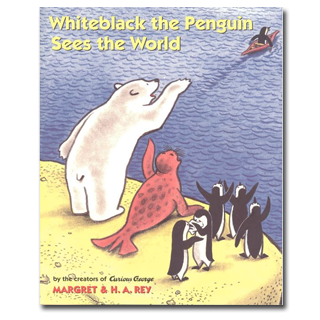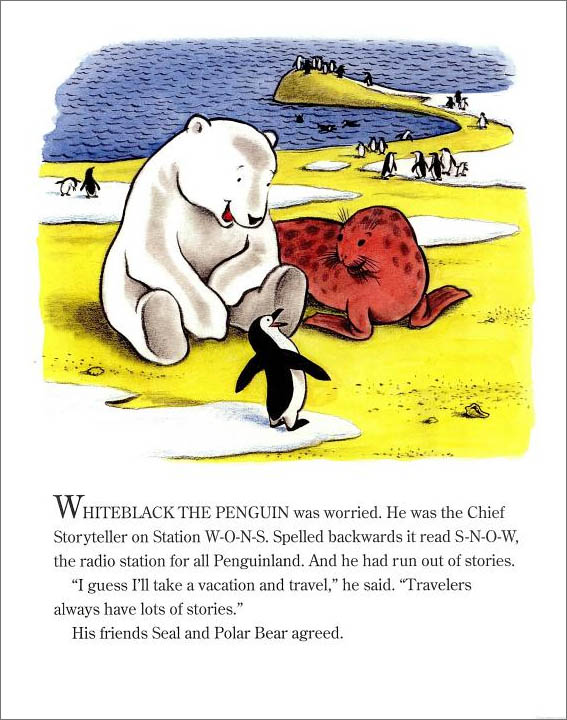
A FEW OTHER EVENTS FOR
FEBRUARY 27:
- Happy birthday Florence Parry Heide (Princess Hyacinth), Uri Shulevitz (Snow), and Mary Kay Kroeger (Paperboy).
- It’s the birth date of Laura Richards (1850–1943), Captain January; Edna Barth (1900–1981), Shamrocks, Harps, and Shillelaghs; and Eric Sloane (1905–1985), A Reverence for Wood.
- Also born on this day was the poet Henry Wadsworth Longfellow (1807–1882). Read Paul Revere’s Ride by Longfellow, illustrated by Ted Rand; and The Midnight Ride of Paul Revere, illustrated by Christopher Bing.
- It’s No Brainer Day. Read The Great Brain by John D. Fitzgerald.
Today marks National Polar Bear Day, to celebrate the world’s largest carnivore. Although we have honored a lot of penguins on this website (Mr. Popper’s Penguins and 365 Penguins), polar bears have received scant notice. So today I’d like to honor a polar bear—although he happens to be the best friend of a penguin. In fact, he’s called only “Polar Bear” in the text; the penguin gets a name, Whiteblack. Possibly penguins are the publicity hounds of the children’s book world—they get all the media attention.
Whiteblack the Penguin Sees the World by Margret and H. A. Rey, better known for their Curious George books, was created in Paris around 1937. The two Germans citizens had met in an advertising agency in Rio de Janeiro, gotten married, and headed for a two-week honeymoon to Paris. They stayed for more than two years and would have stayed longer had the Nazis not interrupted their idyll. Margret, who always knew how to tell a good story, maintained that Hans had been selling bathtubs, up and down the Amazon River, before he met her. When I once asked her if this were really true, she rolled her eyes and said, “Ah, Anita, it was so long ago, and it is such a good story, why do you ask?”
In 1937 Hans worked in the Brazilian Pavilion at the World’s Fair, across from the penguin exhibit. He loved drawing these animals and began work on a story that would feature them—and friends Polar Bear and Seal. In his diaries, he noted that he alternated between working on Whiteblack one day, and then switching to the other book he was developing, Curious George, the next. Eventually, the saga of Whiteblack emerged. A radio announcer, Whiteblack has run out of stories—so he decides to go around the world because travelers have good stories to tell. His friend Polar Bear waves good-bye, and Whiteblack hijacks passage on a naval cruiser, rides a camel, races on a skateboard through the desert, sails on a boat, and eventually brings presents and stories back to his friends.
When the Reys fled Paris in 1940, they brought Whiteblack with them. After they arrived in the United States, they showed it to Grace Hogarth, their editor at Houghton, and Ursula Nordstrom, their editor at Harper. Hans worked on some changes that Nordstrom suggested. Then they abandoned this book for other projects—and Whiteblack, now a fully finished book, sat unpublished. After their deaths, the Reys’ diaries, letters, and manuscripts were donated to the de Grummond Children’s Literature Collection of the University of Southern Mississippi at Hattiesburg. In 1999, while I was looking through an exhibit at the university, I saw the jacket of Whiteblack the Penguin in a case. “I don’t know this one,” I said to curator Dee Jones. “Oh,” she replied, “would you like to see the whole book?” As I opened the jacket, on the inside of the front page, “Propriete de l’auteur H. A. Rey, Paris” sent a chill down my spine. I knew I was looking at a manuscript created by Hans in Paris.
Published for the first time in 2000, Whiteblack the Penguin Sees the World still gives me a chill—a perfectly formed book that spent decades unnoticed, tucked away in other papers. In many ways, the book stands as the autobiography of Hans and Margret—they traveled the world and then had stories to tell. Fortunately, like Whiteblack, they had friends—Grace Hogarth and Ursula Nordstrom and millions of readers—who welcomed them home and delighted in the presents they brought with them.
Here’s a page from Whiteblack the Penguin Sees the World:

Originally posted February 27, 2011. Updated for 2024.













I was not aware of this book, but now I’m curious to read it. In our Children’s Braille Book Club, we always sell out any print/braille Curious George books we offer. Certainly this is proof of the power of their storytelling – they work even without the pictures!
Wow, you saved a book from limbo — that’s exciting. I’ll look for this one; I haven’t seen it before.
Beth: I must admit that the when I realized I held a completely finished work by H. A. Rey in my hands, I was amazed. We still had to do a lot of research to make sure it was authentic. I think of this book as the Rey’s autobiography, written before most of the events happened. Anita
I didn’t know about this book – I’ am eager to look for it in the library!
Wow!!
I can’t believe the story behind this story!
Would you believe it, this is a favorite read-aloud of my twins.
Whenever we read the “Curious George and Friends: Favorite Stories by Margret and H.A. Rey” treasury, they always ask me to read Whiteblack’s story! (Elizabite also fascinates them, as does Pretzel).
In fact, I thought that Whiteblack must be a well known old story… Now I see that in a sense, it is old – but new as well.
I can’t believe how long this story was “hidden” away.
Let me quote Margret Rey’s words: “Ah, Anita, it was so long ago, and it is such a good story”
Anita thanks so much for the great find!
Read Aloud Dad
I don’t know what it is – but I love Polar Bear. This book makes me want to have friends like Seal and Polar Bear. 🙂
Thank you for telling me how much your twins love this story — and for the new take on Margret’s line.
Thank you for rescuing this book and bringing it to the world, Anita. This is a very moving story. My girls LOVE this story so much that our copy looks quite battle scarred. I can’t wait to tell other Rey lovers about this story you’ve shared.
Star: Finding the book was one of the highlights of my career — I loved the idea that this orphan, who had gone through so much stuggle, finally was found.
I was Anita’s Art Director at the time she unearthed “Whiteblack the Penguin Sees the World”. The artwork was in remarkably good condition considering its age. As you might expect, a few things had to be retouched here and there—discolored spots, small tears in the paper, glue marks, etc. However it really did look much as you see it in the printed version. Kudos on your detective work, Anita!
Bob: I have such fond memories of our working on this…
I love Whiteback and I’d missed the story behind it! Thanks! To add to the other good Polar Bear books: Splendid Friend Indeed (and others with polar bear and duck–or goose? by Bloom); Polar Bear Night (Thompson); I Love You With All My Heart (Kem); and the quintessential Irving and Muktuk: Two Bad Bears (and sequels, by Pinkwater).
Love all your stories, I learn so much. Thanks!
What a find! I love those familiar eyes and smile on Polar Bear’s face – so much like Curious George!